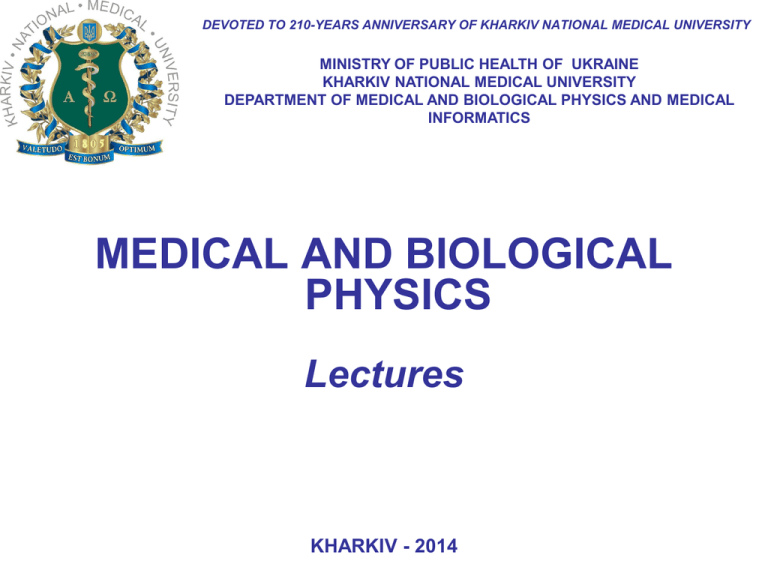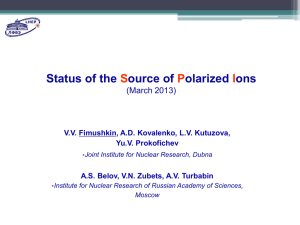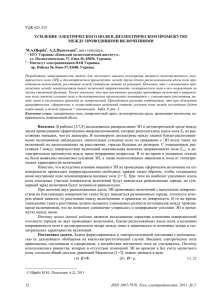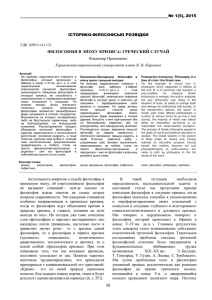Lecture 12 - Polarization
реклама

DEVOTED TO 210-YEARS ANNIVERSARY OF KHARKIV NATIONAL MEDICAL UNIVERSITY MINISTRY OF PUBLIC HEALTH OF UKRAINE KHARKIV NATIONAL MEDICAL UNIVERSITY DEPARTMENT OF MEDICAL AND BIOLOGICAL PHYSICS AND MEDICAL INFORMATICS MEDICAL AND BIOLOGICAL PHYSICS Lectures KHARKIV - 2014 УДК 61:53+577.3](07.07) ББК 28.901я7 М42 Approved by the Academic Council of Kharkiv National Medical University (minute N 5 at 22.05.2014) Reviewers: Berest V.P. - associate professor of Department of Molecular and Medical biophysics, PhD (Math. and Physics), V. N. Karazin Kharkiv National University Timanyuk V.O. - Chief of Department of Physics, professor, National University of Pharmacy Authors: Knigavko V.G., Zaytseva O.V., Batyuk L.V., Bondarenko M.A M42 Medical and Biological Physics. Lectures (in 2 parts): Textbook for students studying the subject in English: In 2 parts / Vladimir G. Knigavko, Olga V. Zaytseva, Lilia V. Batyuk, Marina A. Bondarenko.-Kharkiv: Kh.N.M.U., 2014.; Part I - 337p., Part II - 254p. The Textbook covers the most important topics of medical and biological physics in compliance with the typical educational program. The structure and contents of the lectures completely correspond to credit-module system of educational process organization. The lectures are intended for teachers and students of the medical Universities, as well as for all interested in medical and biological physics. All rights reserved. No part of this publication may be reproduced in any material form (including photocopying or storing in any medium by electronic means and whether or not transiently or incidentally to some other use of this publication) without the written permission of the publishers. УДК 61:53+577.3](07.07) ББК 28.901я7 © Kharkiv National Medical University, 2014 Kharkiv National Medical University POLARIZATION OF LIGHT FUNDAMENTALS OF PHOTOMETRY Department of medical and biological physics and medical informatics Light is known to propagate in the form of electromagnetic waves. The human eye perceives light wavelengths within the range of 380 nm to 760 nm. An electromagnetic wave is the propagation of an alternating electromagnetic field, the direction of oscillations of the electric intensity vector ( E ) and of the magnetic induction vector (B ) being perpendicular to each other, and to the direction of wave propagation. • One can assume that in a single act of radiation the electron in the atom emits a light wave, in which oscillation of vector E occurs in one plane. Ē • Such a wave is called a plane-polarized one. • The light wave emitted by a body as a whole, is formed by addition of waves emitted by a multitude of atoms with different orientation of vectors E chaotically changing in time. Accordingly, the direction of oscillation of vector E of the resulting wave changes. • At this, all the directions of oscillation of the electric intensity vector component are equivalent, and the oscillation amplitudes are approximately equal. Such light is called natural light or non-polarized light. Natural light • Therefore, all natural sources of light emit nonpolarized light. If the oscillation of vector occurs in different directions perpendicular to the direction of light propagation, but the amplitudes of oscillation in some directions notably differ from that in other directions, such light is called partially polarized light. Partially polarized light. • The directions of oscillation of vector E in the plane ( E; B) are shown in Fig. for the cases of natural (a), planepolarized (b) and partially polarized light (c) respectively. • Let us randomly choose two mutually perpendicular planes, passing through a beam of ordinary light, and consider vector projections E on them. Then the average value of these projections will be the same. That is why it is convenient to show ordinary light beam (unpolarized) as a straight line which has equal number of both projections in the form of dashes and dots (a). Thus, straight line with dots or dashes means a beam of plane polarized light (b, c). Natural (a) Plane-polarized (b) Partially polarized light (c) Light having both ordinary and polarized components is called partially polarized. The beam of partially polarized light is shown conventionally by different number of dots and dashes (Fig. d), their relationship reflects a degree of polarization. a c b d Indication of natural (a), plane-polarized (b, c), and partially polarized light (d) • Polarizers are devices that extract polarized light from natural light. Conversion of natural light to completely or partially polarized light is called light polarization. • During incidence of natural light on a polarizer, the intensity I p of polarized light, which exits the polarizer, is one-half the intensity I n of natural light incident on the polarizer. In Ip 2 • If plane-polarized light obtained by means of one polarizer, is incident on another polarizer, called an analyzer, the intensity of light exiting the analyzer, is determined according to the Malus law: 2 I I 0 cos • where I is the intensity of light that has exited the analyzer; I0 is the intensity of light incident on the analyzer (which has exited the first polarizer); and φ is the angle between the plane of polarization of incident light (the principal plane of the polarizer) and the plane, in which the analyzer polarizes light (the principal plane of the analyzer). • It is obvious that, if φ = 0,I = I0 and φ = 90º. I = 0. • Incidence of natural light on the interface of two dielectrics is known to form reflected and refracted rays. At this, in the general case, both of rays are partially polarized, viz. the refracted ray is polarized mainly in the incidence plane, and the reflected ray is polarized in a plane, which is perpendicular to the incidence plane. • If the angle of incidence (αB) meets condition tg B n where n is the index of refraction of the second medium relative to the first one, the reflected ray is completely polarized, and the refracted ray is partially polarized, though the degree of its polarization at this is maximum. • The last relationship is called Brewster's law and the angle of incidence, at which relation is fulfilled, is called Brewster's angle. • Thus, the boundary of two dielectrics or of a dielectric and vacuum is a polarizer. To make the refracted ray completely polarized, a set of thin transparent plates (the Stoletov’s packet) is used. • Partial polarization of the refracted ray occurs on every face of every plate, due to which the degree of light polarization increases, and in emerging from the pile, the light is almost completely polarized. αB • Light polarization also occurs during double refraction (or birefringence). The phenomenon of double refraction is observed in an optically anisotropic media, i.e. in a media whose optical characteristics depend on the direction of light propagation therein. • Typical examples of optically anisotropic media are crystals, for example, Iceland spar. The velocity of light propagation in optically anisotropic crystals differs in different directions. At this, usually there is a direction in which the velocity of light propagation is ultimate (i.e. either maximum, or minimum). This direction is called the optical axis of a crystal. • If a natural light ray is incident on an optically anisotropic crystal, due to light refraction, two rays are formed in the general case O׳ o O e • The law of light refraction holds for one of these rays, i.e. the refracted ray propagates in the plane of ray incidence, and such a ray is called the ordinary ray (o). • The other ray, which is called the extraordinary ray (e), propagates in the plane formed by the incident ray and the crystal optical axis, which passes through the point of ray incidence. This plane is called the principal optical plane. Double refraction is not observed if the ray propagates along the optical axis, and both beams (ordinary and extraordinary) propagate with the same velocity. • Both rays (the ordinary and extraordinary ones) are completely polarized, the extraordinary ray being polarized in the principal plane, and the ordinary ray being polarized in a plane perpendicular to the principal one. • The propagation velocities of the ordinary and extraordinary rays in an optically anisotropic medium are different. Hence, the indices of refraction of the medium are different for these rays. • Crystals, in which the propagation velocity of the ordinary ray (vo) is greater than that of the extraordinary ray (ve), i.e. vo > ve, are called positive crystals. If for a crystal vo < ve, such a crystal is called a negative crystal. • In some crystals with double refraction (tourmaline, herapathite, and others), one of the rays is absorbed more than others are. This phenomenon is called dichroism. As a result, at sufficient thickness of a crystal possessing dichroism property, only one completely polarized ray exits there from. Such crystals can be used as a light polarizers. • To obtain achromatic polarized light, the Nicol prism (or simply the nicol) can be used. The Nicol prism, shown in Fig., is made of Iceland spar, and consists of two parts whose edges are bonded with Canadian balsam. • The index of refraction of Canadian balsam (n = 1.55) is greater than that of Iceland spar (n = 1.49) for the extraordinary ray, but it is less than that of Iceland spar (n = 1.66) for the ordinary ray. • The prism is designed so that the angle of incidence of the ordinary ray (о) on the interface of Iceland spar and Canadian balsam is greater than the angle of total internal reflection. • Due to this, the extraordinary ray passes through the bonded edges of the prism and exits there from, and the ordinary ray is totally reflected at the Iceland spar and Canadian balsam interface. After this, the blackened side face of the prism absorbs it. Hence, only a totally polarized extraordinary ray exits the Nicol prism. Canadian balsam Natural light Optically Active Substances • There are substances, which are able to rotate the plane of light polarization. Such substances are called optically active substances. • At this, the value of angle α is proportional to the length (l) of the path over which the light has passed in the optically active substance, i.e. where is a proportionality constant called rotation constant. 0 where α0 is a proportionality constant called rotation constant. Optically Active Substances α l • The specific rotation of a substance depends on the temperature and the light wavelength. The dependence of specific rotation on the light wavelength is the cause of rotation dispersion, i.e. the dependence of the angle of rotation of the polarization plane on the light wavelength. • Solutions of optically active substances (for example, sugar) in inert solvents (for example, water) are also optically active. For such solutions, the angle of rotation of the plane of polarization of light depends on the concentration of the optically active substance. This dependence is described by the formula 0 c • where c is the concentration of the optically active substance in the solution, and [α0] is a proportionality constant called specific rotation. The specific rotation of an optically active substance solution depends on the wavelength, the solution temperature, and the properties of the solvent. • Dependence of [α0] on the wavelength λ is described by the Biot law [α0]~1/λ2 • As evident, one can determine the concentrations of an optically active substance in the solution by this formula. This method of study is called polarimetry or saccharimetry. The respective instruments are called polarimeters or saccharimeters. Polarizing Microscope • The operation of a polarizing microscope is based on light polarization. A polarizing microscope differs from an ordinary (light field) one in that it contains a polarizer and analyzer. • The polarizer is placed before the condenser and polarizes the light that illuminates the object studied. The analyzer is in the microscope drawtube. • If we have an isotropic sample devoid of optical activity, and the principal planes of the polarizer and analyzer are mutually perpendicular, the field of vision in the polarizing microscope will be dark. At this, either optically anisotropic objects or optically active ones can be observed in the polarizing microscope. • Tissues of living organisms contain various right-handed and lefthanded substances, the total optical activity of biologic tissues being practically equal to zero. So the polarizing microscope is only used for studying structures possessing optical anisotropy. Such structures in the human organism are muscular, bone and neural tissues. Polarization images of the muscular (myocardium) (a), (b) and the large intestine wall (c), (d) tissue histological sections. FUNDAMENTALS OF PHOTOMETRY • Photometry is the branch of optics that deals with the measurement of energy transmitted by electromagnetic waves of the optical range (of wavelengths from 10-8 to 3,410-3m). In the narrower sense, treated of below, photometry refers to the branch of optics devoted to the measurement of the effect of visible light on the human eye (photometric measurements). This effect is characterized by the following photometric quantities: • luminous flux, • luminous intensity, • illumination, • luminous emittance and luminance. • The effect of visible light on the eye depends not only on the physical characteristics of the light (energy flux density, frequency or spectral composition), but also on the spectral sensitivity of the eye (luminous efficiency), which equals the ratio of the luminous flux of the given monochromatic radiation to the energy flux (radiant flux) of this radiation. The quantity Ф V (Ф ) max is called the relative spectral sensitivity of the eye (or relative luminous efficiency). • For a normal eye Vλ = 1 at λ = 5,55·10-7 m. For light vision the dependence of Vλ on λ is called luminous efficiency curve. V(λ) Λ, nm • The luminous flux (Ф) is the power of visible radiation evaluated according to its effect on the eye. • The luminous flux is measured in lumens. • One lumen is luminous flux emitted within unit solid angle Ω (one steradian) by a point source having a uniform intensity of one candela. For monochromatic radiation corresponding to maximum luminous efficiency of radiation (λ = 5,55·10-7 m), the luminous flux equals 683 lumens if the radiant power is equal to 1 watt. • The luminous flux across an arbitrary closed surface enveloping the source of light, is equal to the power of visible radiation of the source and is called the total luminous flux of the light source (Фtot). The spectral density of visible radiation of a source of nonmonochromatic radiation is the quantity Ф е dФ d where dФ is the total luminous flux for the wavelength range from λ to λ + dλ. Ф v k V() e d 0 • The luminous intensity of a point source is the quantity I, numerically equal to the luminous flux emitted by the source within a unit solid angle. If the point source radiates uniformly in all directions then its luminous intensity is: Ф tot I 4 where Фtot is the total luminous flux of the source. • Luminous intensity is measured in candelas. The fundamental SI unit is that of luminous intensity of a light source – the candela (cd) – whose magnitude is such that the luminance of a full radiator (black body) at the temperature of solidification of platinum is 60 candelas per square centimeter. • The illumination (E) of a surface is the ratio of the luminous flux dФ incident on an element of the surface to its area dS. Thus: dФ Е dS • For a point source of light we get: I cos E R2 • where R is radians vector drawn from the source to the element dS of illuminated surface; φ is an angle of incidence. • If a plane light wave falls on the surface then we obtain E E 0 cos • where E0 is illumination of a surface normal to the direction of propagation of the wave; φ is an angle between the normal surface and that being considered. • Illumination is measured in luxes and phots. One lux (lx) is the illumination of the surface of a sphere of one meter radius produced by a point source at its centre having a luminous intensity of one candela. Nonsystem unit of illumination is phot (ph): 1 ph = 104 lx. • The quantity of illumination (exposure) H is the product of illumination E of a surface by the duration t of its illumination (in photography it is called the exposure time). Thus: H = Et • The luminance (Bφ) is the surface density of the luminous intensity in a given direction. It equals the ratio of the luminous intensity to the projected area of the luminous surface on a plane perpendicular to the given direction. Thus: d Ф B dS cos dS d cos dI 2 • where dI is a luminous intensity of element dS of the luminous surface in the direction making the angle φ with the normal to the element dS; d2Ф is luminous flux emitted by element dS within solid angle dΩ in the same direction. • The luminance is measured in nits and stilbs. One nit (nt) is the luminance of a luminous plane surface in a direction perpendicular to it, if in this direction the luminous intensity equals one candela per square metre (1 nt = 1 cd/m2). Nonsystem unit of luminance is stilb (sb): 1 sb = 104 nt. • A light source for which Bφ does not depend on φ is said to be obey Lambert’s law. • The luminous emittance (R) is the surface density of the luminous flux of radiation emitted by a surface. It equals the ratio of the luminous flux dФ to the area dS of luminous surface: dФ R dS • The luminous emittance is measured in luxes and phots. • The relationship between luminous emittance and luminance for sources obeing Lambert’s law is R B Thank You for Attention! Literature 1. Биофизика: учебник для вузов / П.Г. Костюк, Д.М. Гродзинський, В.Л. Зима и др.; Под общ. ред. П.Г. Костюка .- К.: Вища шк., 1988. 504 с. 2. Биофизика / Ю.А. Владимиров, Д.И. Рощупкин, А.Я. Потапенко, А.И. Деев.– М.: Медицина, 1983. – 272 с. 3. Волькенштейн М.В. Биофизика. – М. : Наука, 1988. - 590 с. 4. Вибрационная безопасность. Общие требования. ГОСТ 12.1.012-90. – М., 1990. 5. Гамалея Н.Ф., Рудых З.М., Стадник В.Я. Лазеры в медицине. – К.: Здоровье, 1988. – 43 с. 6. Гродзинський Д.М. Радіобіологя. – К.: Либідь, 2000. – 448 с. 7. Губанов В.И., Утепбергенов А.А. Медицинская биофизика. – М.: Медицина, 1978. – 336 с. 8. Ємчик Л.Ф., Кміт Я.М. Медична і біологічна фізика. – Львів.: Світ, 2003. - 592 с. 9. Кольченко В.В., Паничкин Ю.В. Ультразвук и сердце. – К.: Здоровья, 1988. – 45 с. 10. Кортуков Е.В., Воеводский В.С., Павлов Ю.К. Основы материаловедения. – М.: Высшая школа, 1988.– 322 с. 11. Котык А., Яначек К. Мембранный транспорт. Междисциплинарный подход. – М.: Мир, 1980. – 341 с. 12. Луизов А.В. Физика зрения. – М., Знание, 1976. – 62 с. 13. Маршелл Э. Биофизическая химия. Принципы, техника и приложения. В 2-х томах. – М.: Мир, 1981. – 824 с. 14. Мэрион Дж. Общая физика с биологическими примерами. – М.: Высшая школа, 1986. – 623 с. 15. Медична і біологічна фзика.Том 1. / О.В.Чалий, Б.Т.Агапов, А.В. Меленевська та ін. – К.: ВІПОЛ, 1999. – 425 с. 16. Медична і біологічна фзика. Том 2. / О.В.Чалий, Б.Т.Агапов, А.В. Меленевська та ін. – К.: ВІПОЛ, 2001. – 415 с. 17. Проблемы прочности в биомеханике / И.Ф.Образцов, И.С.Адамович, А.С.Барер и др. – М.: Высшая школа, 1988. – 311 с. 18. Рего К.Г. Метрологическая обработка результатов технических измерений. – К.: Техніка, 1987. – 128 с. 19. Ремизов А.Н. Медицинская и биологическая физика. – М.: Высшая школа, 1999. – 616 с. 20. Рубин А.Б. Биофизика / Учеб. пособие для биол. спец. вузов. – М.: Высш. шк., 1987. – 319 с. (1 том) 302 с (2 том) 21. Рубин А.Б. Термодинамика биологических процессов / Учеб. пособие для вузов. – М.: Изд-во МГУ, 1984. – 285 с. 22. Стенли А. Гельфанд. Слух: введение в психологическую и физиологическую акустику. – М.: Медицина, 1984. – 352 с. 23. Тиманюк В.А., Животова Е.Н. Биофизика. – Харьков: Изд-во НФАУ; Золотые страницы, 2003. – 704 с. 24. Ультразвук. Маленькая энциклопедия. Глав. ред. И.П.Голямина. – М.: Советская Энциклопедия, 1979. – 400 с. 25. Ультразвук. Общие требования безопасности. ГОСТ 12.1.001-89. – М., 1989. 26. Физика визуализации изображений в медицине: В 2-х т. Том 1; пер. с англ./Под ред. С.Уэбба. – М.: Мир, 1991. – 408 с. 27. Физика визуализации изображений в медицине: В 2-х т. Том 2; пер. с англ./Под ред. С.Уэбба. – М.: Мир, 1991. – 423 с. 28. Фотометрия. Термины и определения. ГОСТ 26148-84. – М., 1984. 29. Хауссер К.Х., Кальбитцер Х.Р. ЯМР в медицине и биологии: структура молекул, томография, спектроскопия in-vivo. – К.: Наук. Думка, 1993. – 259 с. 30. Холл Э. Дж. Радиация и жизнь. – М.: Медицина, 1989. – 256 с. 31. Шандала М.Г., Думанский Ю.Д., Иванов Д.С. Санитарный надзор за источниками электромагнитных излучений в окружающей среде. – К.: Здоровье, 1990. – 150 с. 32. Шум. Допустимые уровни в жилых и общественных зданиях. ГОСТ 12.1.036-81. – М., 1981. 33. Электростатические поля. Допустимые уровни на рабочих местах и требовании к проведению контроля. ГОСТ 12.1.045-84. – М., 1984. 34. Ярмоненко С.П. Радиобиология человека и животных. - М.: Высшая школа, 1988. – 423 с.










